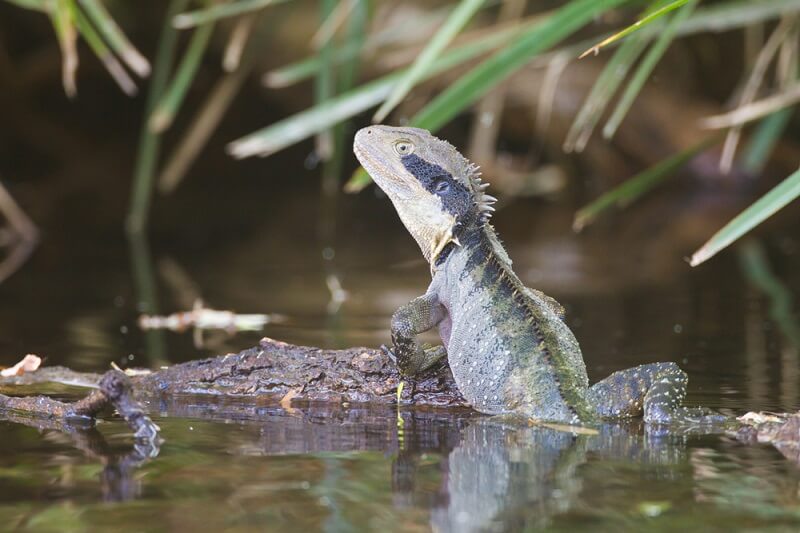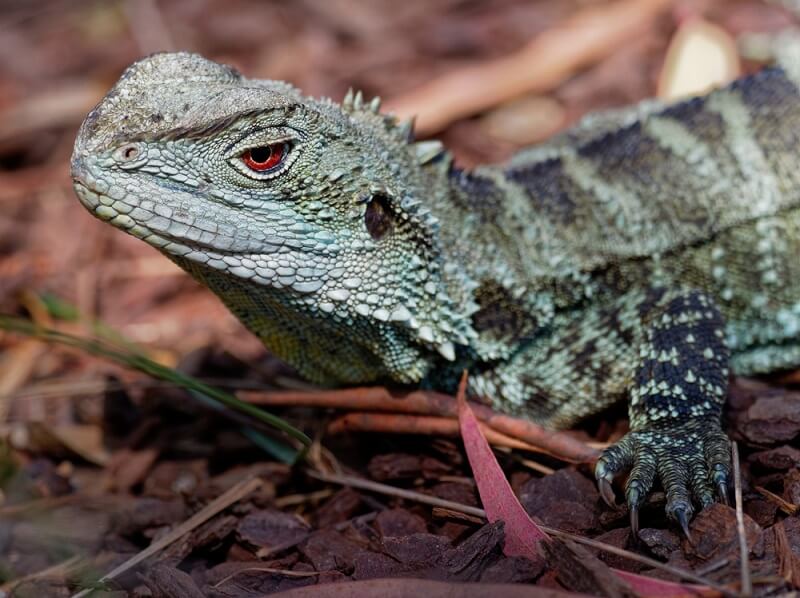
| Kingdom | Animalia |
| Phylum | Chordata |
| Class | Reptilia |
| Order | Squamata |
| Family | Agamidae |
| Genus | Physignathus + Intellagama |
| Species | Physignathus cocincinus (Chinese) + Intellagama lesueurii (Australian) |
| Niche | Forest-Dwelling Insectivore |
| Length | Up to 3.3 ft (1 m) |
| Weight | Up to 2.2 lbs (1 kg) |
| Lifespan | 10-15 years |
| Social Structure | Small, hierarchical groups |
| Conservation Status | Vulnerable |
| Preferred Habitat | Tropical Rain Forests, near water |
| Average Clutch Size | Around 7 eggs |
| Main Prey Species | Insects, though some vegetation is also eaten |
| Predators | Large birds, mammals, other reptiles, humans |
The Basics
The water dragon is a type of lizard native to Southeast Asia, Australia, and New Guinea. They are known for having a crest on their neck and a well-developed ability to swim and hold their breath. In fact, the main defense of the water dragon is to drop from the trees into a river or lake. Here, they can remain hidden underwater for up to 90 minutes!
While the water dragon is commonly kept as a pet, the species is considered “Vulnerable” in the wild – in part due to the pet trade. Plus, while the pet trade has depleted the water dragon from its natural environment, it has also established invasive populations in other areas. So, keeping a water dragon as a pet is questionable, at best. However, captive breeding operations may help reduce the harvest of water dragons from the wild.

In their natural environment, water dragons are very interesting lizards. Related to other “dragon” species in the subfamily Amphibolurinae, the water dragon consists of two main species: the Australian water dragon and the Chinese water dragon. The Australian water dragon is a grayish-brown color and often has a black stripe on its eye. By comparison, the Chinese water dragon is a greenish color that does not have a stripe on its eye. Both species have a frilled crest just behind their rather large head.
Water dragons are insectivores, feeding on a wide variety of insects found in tropical and subtropical environments. When they are not hunting insects, the water dragon spends its time basking in the trees. Water dragons tend to form hierarchical social groups, with the biggest males and females getting the best basking spots and mating opportunities.
Interesting Insights from the Water Dragon!
While the water dragon has a mythical name, it is actually a perfect species to explain several different biological concepts that are very real.
Pineal Eye
Like most reptiles, water dragons have an organ known as the pineal eye. Between their eyes lies a small, iridescent patch of scales that cover light-receiving nerve endings. Many lizards use this organ to sense the intensity of sunlight, which helps them determine which spots are the best places to bask. Basking is necessary for lizards because it raises their body temperature, allowing them to keep their temperature in a specific range. What’s more interesting is that humans (and all mammals) have a similar structure – the pineal gland.

Though the human pineal gland is buried deep within our brains, it is connected to neurons in the eye. When our eyes perceive light, a signal is sent to the pineal gland. This signal causes the pineal gland to stop producing melatonin, a hormone crucial to our sleep and wake cycles. When no or very little light is detected by the pineal gland, it again starts to release melatonin. This hormone affects many parts of your brain and body – preparing you for sleep! This helps regulate our circadian rhythm and keeps our bodies healthy.
Parthenogenesis
Parthenogenesis is an ability that some animals have to reproduce asexually, even though the species is normally sexually reproducing. Through parthenogenesis, a female is able to create viable offspring – without ever having been fertilized by a male. Essentially, this is equivalent to a virgin birth!
The water dragon is one of only a few species that has been observed completing parthenogenesis. Through this process, an unfertilized egg goes through a duplication event to become a diploid cell. If the female’s genetics do not contain a large number of deleterious recessive mutations, the offspring can be viable. Studies on water dragons have shown that parthenogenesis does occur, and genetic analysis showed that these offspring were almost identical to the female they came from.

Interestingly, parthenogenesis is seen in a number of other reptiles including garter snakes, Colombian rainbow boas, and common boas. However, it is much more common in invertebrates like insects, snails, worms, and microscopic organisms. Still, parthenogenesis has been seen in birds, sharks, and other groups – though it is usually limited to a single species and is incredibly rare.
